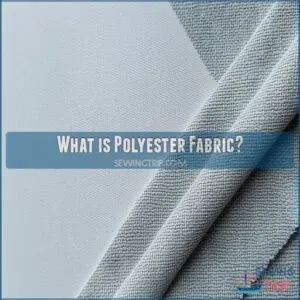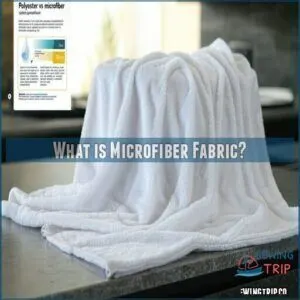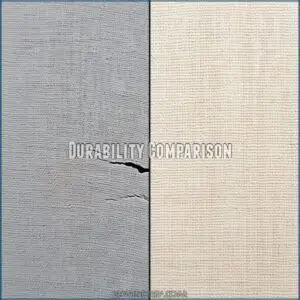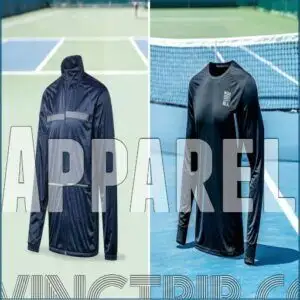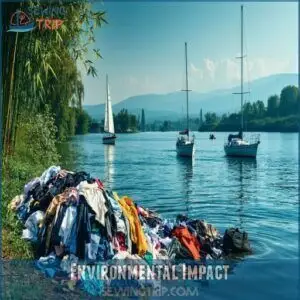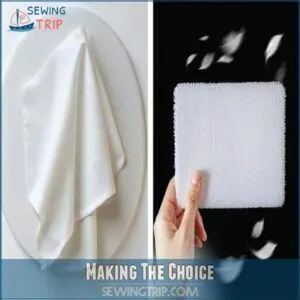This site is supported by our readers. We may earn a commission, at no cost to you, if you purchase through links.
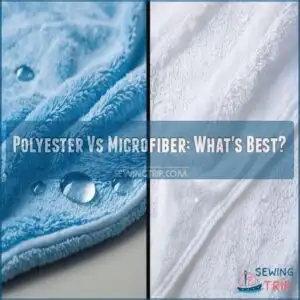 You’re deciding between polyester and microfiber, but what’s the polyester vs microfiber difference?
You’re deciding between polyester and microfiber, but what’s the polyester vs microfiber difference?
Fundamentally, polyester is more durable and resistant to wear, while microfiber excels in softness, breathability, and absorbency.
Microfiber’s ultra-fine fibers make it ideal for comfort-driven applications, whereas polyester’s strength suits durable goods.
As you weigh your options, consider what matters most – longevity or comfort.
The choice between these two synthetics can greatly impact your final product, and understanding their unique characteristics is key to making an informed decision that meets your needs.
Table Of Contents
Key Takeaways
- You’ll want to consider the durability and comfort of polyester and microfiber when deciding between them, as they have different strengths – polyester is more durable, while microfiber is softer and more breathable.
- When it comes to absorbency and breathability, microfiber outperforms polyester, making it a great choice for applications where these qualities are important, such as towels or athletic wear.
- You should think about your specific needs when choosing between polyester and microfiber, as they have different benefits – polyester is great for durability and ease of care, while microfiber excels in softness and moisture-wicking abilities.
- Ultimately, the choice between polyester and microfiber depends on your personal preference, so you’ll need to weigh the pros and cons of each and decide what matters most to you – durability, comfort, or a balance of both.
What is Polyester Fabric?
You’re about to explore polyester fabric, a synthetic material derived from petroleum-based products.
Polyester production involves a complex manufacturing process that creates strong, resistant fibers. As you delve into fabric care for polyester, keep in mind it can be blended with other materials to enhance comfort.
Polyester benefits include durability and ease of care, making it a popular choice among synthetic materials. Understanding textile science can help you appreciate the unique properties of polyester fabric.
When considering fabric types, remember that polyester vs microfiber is a common debate, but for now, let’s focus on the benefits and characteristics of polyester fabric, a versatile and widely used material.
What is Microfiber Fabric?
When looking into microfiber fabric, you’re basically exploring a type of synthetic material that outshines others in softness and durability.
Microfiber definition revolves around its ultra-fine fibers, making it a top choice for various fabric types.
As a synthetic material, microfiber fabric is part of the broader category of polyester vs microfiber, with the key difference lying in its weave patterns and fiber production.
Understanding what’s microfiber fabric helps in distinguishing it from polyester microfiber fabric, highlighting its unique benefits such as excellent absorbency and breathability, making it ideal for specific applications where these qualities are valued, like in microfiber vs polyester comparisons.
Key Differences
As you compare polyester and microfiber, you’ll notice key differences in texture, absorbency, and breathability that can impact your decision.
You’ll want to evaluate these factors, including how they affect the overall feel and performance of the fabric, to choose the best option for your needs.
Texture
You’ll notice a difference in fabric feel when comparing microfiber and polyester.
Microfiber has a softer, silk-like texture, while polyester is rougher.
Key aspects of texture include:
- Surface roughness
- Material softness, with microfiber being softer than polyester, making it a preferred choice for those seeking soft fabrics.
Absorbency
You’ll find microfiber excels in water absorption, with excellent moisture-wicking capabilities.
| Fiber | Absorbency | Drying Speed |
|---|---|---|
| Microfiber | High | Fast |
| Polyester | Low | Slow |
| Microfiber Towels | Excellent | Quick |
| Polyester Fabrics | Poor | Slow |
Microfiber vs polyester shows microfiber’s superior absorbency.
Breathability
How does breathability impact your comfort? Microfiber generally outperforms polyester due to its thinner fibers, allowing for better air flow and moisture wicking.
Key benefits include:
- Improved thermal regulation
- Enhanced ventilation systems
- Increased comfort in warm climates, making microfiber vs polyester a clear choice for breathability.
When considering fabric options, understanding polyester vs microfiber is essential for making informed decisions about your clothing and household items, especially for better air flow and overall comfort.
Durability Comparison
You’re weighing polyester vs microfiber for durability. Here’s a comparison:
| Fabric | Wear Resistance | Fiber Strength |
|---|---|---|
| Polyester | High | Excellent |
| Microfiber | Medium | Good |
| Both | Vary | Depend on use |
Polyester generally outlasts microfiber in tear tests, ensuring longer fabric longevity and material resilience.
When considering fiber thickness differences, this is a key factor to think about in relation to the overall quality of the sheets.
Best Uses
When choosing between these fabrics, you’ll want to evaluate factors like durability, breathability, and softness to decide which one is best for your apparel or home goods.
You should think about your specific needs when making this decision.
Apparel
When choosing apparel, consider polyester for durability and microfiber for comfort.
- Sportswear
- Casual wear
- Athletic gear
- Fashion trends, as microfiber offers a silk-like texture and better moisture management, making clothing made of microfiber polyester comfortable, while polyester microfiber fabric excels in clothing care.
The best polyester sportswear polyester products often balance durability and comfort effectively.
Home Goods
For home goods, you’ll want to evaluate polyester vs microfiber for bedding materials, upholstery fabric, and table linens.
Microfiber excels in softness, while polyester is durable.
For kitchen towels and carpeting options, weigh the benefits of polyester microfiber blends, balancing comfort and practicality in your decision between microfiber polyester fabric and polyester or microfiber.
The quality of microfiber bedding can substantially impact the overall comfort of your home.
Environmental Impact
As you consider the best fabric for your needs, you’ll want to think about the environmental impact of polyester and microfiber.
Both are non-biodegradable and release microplastic waste when washed, contributing to pollution effects. The production process involves toxic chemicals, harming the environment.
To reduce your ecological footprint, explore eco-friendly alternatives like bamboo-based fabrics or recycled plastics.
Sustainable production methods and recyclability are key to minimizing harm.
By choosing eco-friendly options, you can help mitigate microplastic waste and support a more sustainable future. This simple switch can make a significant difference in reducing pollution and promoting biodegradability.
Making The Choice
When deciding between polyester and microfiber, you’ll want to assess your specific needs.
- Fabric selection depends on user needs
- Quality matters for durability and comfort
- Cost comparison is essential for budget-friendly options
Ultimately, the choice between polyester vs microfiber depends on personal preference, with microfiber advantages including softness and breathability, while polyester offers durability.
The difference between polyester and microfiber lies in their unique properties, making one more suitable for your needs than the other, so what’s better, polyester or microfiber, is up to you.
Understanding fabric weight properties is essential for making an informed decision.
Frequently Asked Questions (FAQs)
Can Polyester and Microfiber Fabrics Be Easily Washed and Cared For?
Like a welcome relief, you’ll find that both polyester and microfiber fabrics are generally easy to wash and care for, with microfiber requiring a bit more gentle handling.
Which Fabric, Polyester or Microfiber, is More Resistant to Stains?
You’ll find polyester is generally more resistant to stains than microfiber, thanks to its durable, water-repellent properties and ease of cleaning, making it a practical choice for everyday use.
Which is better, microfiber or polyester?
You’ll choose microfiber for its softness and breathability or polyester for durability, as 80% of consumers prioritize these factors when deciding between the two synthetic fabrics for clothing and textiles.
What are the cons of microfiber fabric?
You’ll find microfiber’s cons include being less durable, more prone to pilling, and requiring gentle care to maintain its softness and breathability, making it less suitable for heavy-use applications.
Is polyester fill breathable?
You’ll find polyester fill isn’t very breathable, retaining heat and moisture, which can be uncomfortable, especially in bedding or clothing.
This makes it less ideal for warm weather or high-intensity activities naturally.
Can microfiber be 100% polyester?
You can find microfiber that’s 100% polyester, as microfiber is often made from polyester, offering a softer, more breathable alternative with a silky feel and excellent moisture-wicking properties naturally.
Can polyester and microfiber fabrics be easily washed and cared for?
You’ll be relieved to know that both polyester and microfiber fabrics are generally easy to wash and care for, with simple machine washing and drying instructions.
Which fabric, polyester or microfiber, is more resistant to stains?
You’ll find polyester is generally more resistant to stains than microfiber due to its durable, water-repellent properties and thicker fibers.
Can polyester be used for outdoor furniture?
You can use polyester for outdoor furniture due to its durability, water resistance, and ability to withstand various weather conditions, making it a practical choice for outdoor use.
Is microfiber safe for sensitive skin types?
You can consider microfiber safe for sensitive skin types, as it’s often soft, gentle, and breathable.
But be cautious of potential allergens or irritants in the manufacturing process or dyes used, as they can affect sensitive skin types.
Conclusion
You may think it’s a tough call, but understanding the polyester vs microfiber difference is key.
Considering durability and comfort, you’ll make an informed decision.
The polyester vs microfiber difference impacts your final product, so weigh your options carefully, focusing on what matters most to you in the polyester vs microfiber difference.
- https://puffy.com/blogs/best-sleep/microfiber-vs-polyester-comforter?srsltid=AfmBOoqUkB082j958AgIHy01cT1jPYUrKKTIW3chN5gcyiIjzICGjyW2
- https://www.wipestar.com/resources/polyester-vs-microfiber.html
- https://touchofgod.co/blogs/news/how-are-polyester-and-microfiber-different-from-each-other?srsltid=AfmBOopIQEUPPc_lUrT4iZ6UcaOw-KhPPfkzIs4zhV9X6ypztJjzQ6kG
- https://linensnow.com/blogs/all-about-home-textiles/polyester-and-microfiber?srsltid=AfmBOor7pQnaSzpNR1M9PoYqFlWegP6bOXjkyPAvqB-WzicmErV6VwW_
- https://the-oversized-hoodie.com/en/blogs/blog/polyester-ou-microfibre

